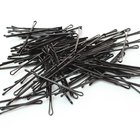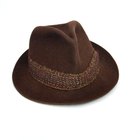Lapel pins came into popularity as a means of showing your support for a presidential candidate. A prized collector's lapel pin shows Abraham Lincoln. Since then, the lapel pin has become a way to show your passion and support for a variety of interests, from politics to sports and beyond. Since lapel pins are most often worn with dress suits, learning how to attach a lapel pin without ruining a shirt is important. Lapel pins worn on a jacket are not much cause for concern because the fabric is heavier, but placing the pin on a dress shirt also is popular.
Pinning Your Shirt
Remove the back from your lapel pin. The back is a round, brass-colored back that pushes onto the sharp end of the pin, covering the point of the pin and preventing the lapel pin from falling off your shirt.
Stand in front of a mirror while wearing the shirt, and select a position for the pin. There are two common placements: on the collar and on the pocket.
Attach the lapel pin to the shirt. Push the sharp point of the pin through the fabric at a stitched seam on the collar or the pocket. The seam will help hide the hole when you are not wearing the pin. Push the pin in until the back of the pin face is flush to the fabric, then press the pin into the back of the pin inside the shirt.
Related Articles

What Is the Proper Placement of a Lapel ...

How to Put a Boutonniere on a Shirt

How to Stop Female Facial Hair

How to Tie a Necktie Step-by-Step

How to Adjust the Wristband on Armitron ...

How to Cook Tender Rolled Flank Steaks ...

How to Tie a Bandana Skull Cap

How to Grill Perch

The Difference Between Houndstooth & ...

How to Make a Compelling Argument

What Does It Mean to Score Roast Pork?

How to Remove Stainless Steel Links ...

How to Keep Your Hat on With Bobby Pins

How to Shorten the Band of a Fossil ...

The History of Pinstripe Suits

How to Make a Wool Jacket Look New Again

How to Roast an Eye Round Roast at High ...

How to Fix a Stalled Second Hand on a ...

1950s Gangster Clothes

How to Put the String Back Into My ...
Writer Bio
Cassandra Tribe has worked in the construction field for over 17 years and has experience in a variety of mechanical, scientific, automotive and mathematical forms. She has been writing and editing for over 10 years. Her areas of interest include culture and society, automotive, computers, business, the Internet, science and structural engineering and implementation.